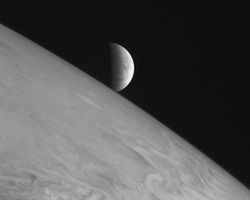Difference between revisions of "Europa"
From FenWiki
m |
m (added txt to the infobox) |
||
| Line 10: | Line 10: | ||
|atmosphere=Trace | |atmosphere=Trace | ||
|waterice= | |waterice= | ||
| − | |population= | + | |population=transient only, no permanent residents |
| − | |political= | + | |political=[[Fenspace Convention]] |
|government= | |government= | ||
| − | |capital= | + | |capital=administered from [[Serenity Valley]], [[Ganymede]] |
}} | }} | ||
Revision as of 22:03, 27 November 2010
| Europa | |
 | |
| Planetary characteristics | |
|---|---|
| Orbit | 670 900 km from primary (mean) |
| Diameter | 3138 km (equatorial) |
| Surface Gravity | 0.134 g |
| Year | n/a |
| Day | Synchronous with primary |
| Mean Temperature | 102°K |
| Atmosphere | Trace |
| Population (2013) | transient only, no permanent residents |
| Political Affiliation | Fenspace Convention |
| Capital | administered from Serenity Valley, Ganymede |
Europa (also known as "Jupiter II") is the sixth moon of the planet Jupiter and the smallest of the four Galilean moons. It was discovered in 1610 by Galileo Galilei (and possibly independently by Simon Marius).
Europa in Fenspace
Europa was first visited in 2008 by a group of Browncoat prospectors. Since then, multiple scientific expeditions have landed on the surface, leaving behind robots searching for life underneath the ice crust.
No permanent settlements are located on Europa. Officially, the reason is Europa's proximity to the Jovian radiation belts; the higher than normal amounts of ionizing radiation makes long-term settlements unviable. Unofficially, however, everybody knows that all these worlds are ours except Europa.
Related Links